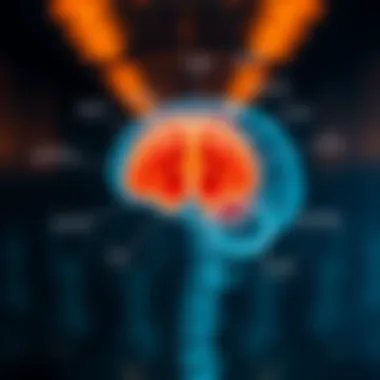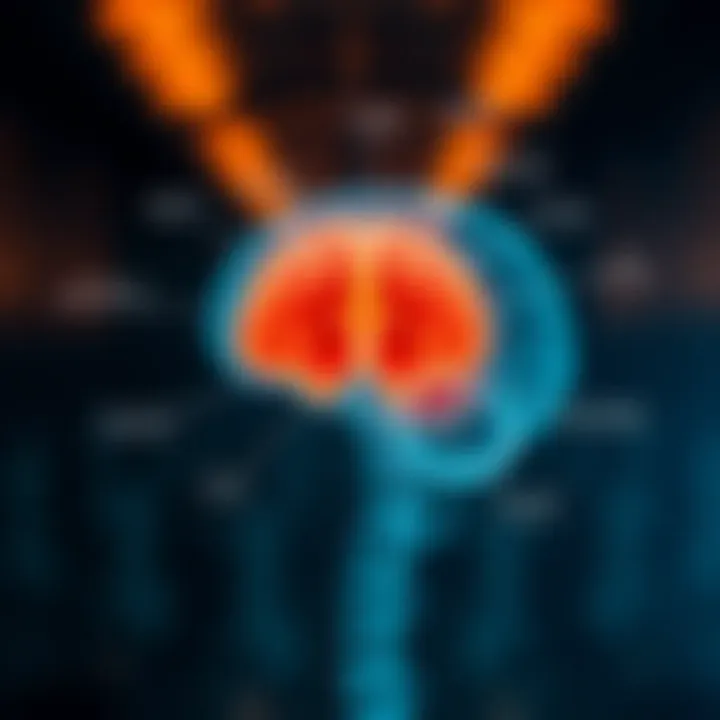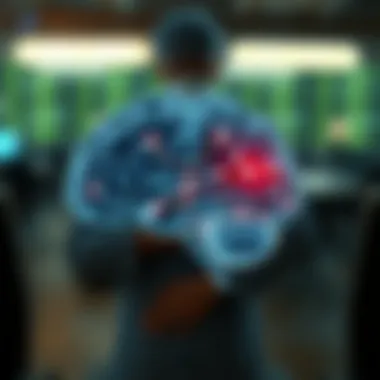The Amygdala's Influence on PTSD and Emotional Regulation


Intro
Understanding the intricate connections between our brain's structures and our emotional states can feel like peeling an onion, with layers that reveal complex insights into our responses to trauma. One of the pivotal players in this emotional symphony is the amygdala, an almond-shaped cluster of nuclei located in the temporal lobe. When discussions about post-traumatic stress disorder (PTSD) arise, the amygdala frequently takes center stage due to its critical role in fear processing and emotional regulation. The myriad functions of this brain structure serve as a foundation for unraveling the neurobiological underpinnings of PTSD, a condition that affects millions and shapes lives in profound ways.
Diving deep into the mechanisms at play can illuminate why some individuals develop PTSD after traumatic experiences, while others seem to handle similar events with relative ease. This exploration not only enhances our understanding of PTSD but also opens doors for potential therapeutic avenues. Given the increasing prevalence of PTSD in various populations, comprehending the amygdala's functionality has become more essential than ever. This article aims to unpack the roles of the amygdala in the context of PTSD, painting a rich, detailed landscape of its influence on our mental health.
Research Overview
In the quest to comprehensively understand the relationship between the amygdala and PTSD, it’s crucial to look at the current body of research.
Summary of Key Findings
Recent studies shed light on several key findings:
- The amygdala is significantly hyper-responsive in individuals diagnosed with PTSD, leading to heightened fear responses.
- There is a notable reduction in the activation of the prefrontal cortex, which is responsible for regulating emotional responses, in individuals suffering from PTSD when faced with stressors.
- Neuroimaging has shown that prolonged exposure to trauma can cause structural changes in the amygdala, contributing to persistent anxiety and fear.
These findings signal a desperation call for further research and highlight how crucial it is to focus on the amygdala when considering treatments for PTSD.
Methodologies Employed
Researchers have utilized a variety of methods to assess the role of the amygdala in PTSD:
- Functional Magnetic Resonance Imaging (fMRI): This technique has been pivotal in capturing the real-time activity of brain regions during exposure to stimuli that evoke fear.
- Electrophysiological studies: These investigations help scientists understand the electrical activity of neurons within the amygdala, elucidating how it processes emotionally laden information.
- Animal models: Exploring amygdala functioning in controlled environments provides insight into the molecular and cellular changes associated with PTSD and may lead to better treatments.
With these methodologies, researchers have been able to trace the pathways through which the amygdala influences emotional distress, contributing to a granular understanding of PTSD’s slice of the human experience.
In-Depth Analysis
Armed with insights from various studies, the analysis of how the amygdala functions and its implications for PTSD becomes clearer.
Detailed Examination of Results
Findings consistently demonstrate that increased amygdala activity correlates with emotional dysregulation characteristic of PTSD. When confronted with reminders of trauma, individuals often exhibit a dramatic rise in amygdala activation, which may trigger an overwhelming sense of fear and anxiety—key symptoms of the disorder. This chronic state of hypervigilance perpetuates the trauma's grip on the individual, affecting daily functioning and overall quality of life.
In addition to increased activity, the interplay between the amygdala and the hippocampus—the area associated with memory—contributes to the reliving of traumatic events experienced by those with PTSD. These individuals often find themselves stuck in a loop of intrusive thoughts and memories, isolated from the reality that surrounds them.
Comparison with Previous Studies
Looking back at earlier research provides context to these findings. Previous studies indicated that the amygdala primarily acted as a fear center, yet more recent findings have elaborated on its complex web of interactions with other brain structures. This evolution in understanding coincides with advancements in neuroimaging and technological innovations in measuring brain activity.
Some earlier hypotheses suggested that the amygdala's fear response was more straightforward and reflexive. Current perspectives, however, illuminate the amygdala's role not merely as a fear generator but as a participant in a dynamic emotional regulation process that influences how trauma is processed and remembered.
By synthesizing past and present findings, we gain a richer understanding of PTSD’s neurobiological foundations and highlight the amygdala's multifaceted nature in the landscape of emotional disorders.
Prolusion to the Amygdala and PTSD
Understanding the intricate relationship between the amygdala and post-traumatic stress disorder (PTSD) is pivotal in unraveling the complexities of how trauma shapes our emotional health. This section will anchor the discussion about significant aspects of both the amygdala's function and the mechanism of PTSD.
As we delve into the role of the amygdala, we’ll discover how this small, almond-shaped cluster of nuclei plays a crucial role in the emotional landscape of human experience. The amygdala is often likened to a watchman on high alert, constantly monitoring for threats and danger. When PTSD occurs, this watchman may become overly sensitive, leading to a cycle of fear, anxiety, and distress.
The importance of highlighting the amygdala in the context of PTSD extends beyond mere academic interest. It opens pathways for effective treatments, deeper understanding of emotional responses, and insights into trauma recovery. The exploration of this connection could potentially enhance methods for diagnosis and foster the development of targeted therapies, ultimately providing hope to many suffering from such debilitating consequences of trauma.
Defining PTSD
Post-traumatic stress disorder (PTSD) is a mental health condition triggered by experiencing or witnessing a traumatic event. The symptoms can be deeply immersive, often including flashbacks, nightmares, severe anxiety, and uncontrollable thoughts about the incident. PTSD does not merely disrupt the life of the affected individual; it can ripple out, impacting relationships, work, and overall quality of life.
Various types of trauma could lead to PTSD, such as military combat, sexual assault, or the sudden loss of a loved one. The trauma becomes a part of one’s mental fabric, leaving lasting imprints that might not easily fade away. In fact, according to the National Center for PTSD, roughly 7-8% of the U.S. population will experience PTSD at some point in their lives. This statistic underscores the importance of addressing PTSD not just as an individual struggle but as a societal issue.
Overview of the Amygdala
The amygdala is essential in the brain's emotional processing system. Typically, it's about the size of an almond and situated deep within the temporal lobe of the brain. Its primary functions extend beyond merely recognizing threats; it's deeply involved in forming emotional memories and navigating social behaviors, thus laying the groundwork for emotional learning.
To describe its role in just a few terms wouldn't do justice. The amygdala connects with multiple brain regions, including the hippocampus, which is key in memory formation, and the prefrontal cortex, which is involved in executive functions such as decision-making. This connectivity is significant; when one part of this system is disrupted, it can lead to a domino effect that heightens emotional responses.
The Connection Between the Amygdala and Emotions
Emotions are, for better or worse, integral to the human experience, and the amygdala is like a sensory hub that processes these feelings. When faced with a potential threat, the amygdala identifies this as a danger signal and coordinates the body's response, preparing it for fight or flight. In a way, the amygdala's reactions are the mental equivalent of a smoke alarm—vital but sometimes prone to false alarms.
In someone with PTSD, this connection can become maladaptive. The amygdala may overreact, leading to heightened states of fear and anxiety triggered by reminders of the trauma. Here lies a stark contrast; while it is designed to protect us, in the case of PTSD, the amygdala's hyperactivity can lead to overwhelming emotional distress, thus demonstrating its dual nature. Recognizing this dynamic connection between the amygdala and our emotions serves as a significant step toward understanding PTSD.
"In the case of PTSD, the amygdala becomes not merely a processor of emotions but often a perpetual source of distress."


The amygdala's role in both standard emotional processing and in conditions like PTSD illustrates how intertwined our brain functions are with our psychological state. Understanding these links not only informs clinical interventions but also inspires a methodical approach to combatting the aftereffects of trauma.
Neuroscience of the Amygdala
Understanding the neuroscience of the amygdala is vital in grasping its profound influence on PTSD. This almond-shaped structure is nestled deep within the temporal lobe and serves as a critical hub for processing emotions. When one considers the amygdala's role, it becomes clear that its functioning can directly impact our responses to stress and trauma. A deeper comprehension of the amygdala can guide better therapeutic interventions for those grappling with PTSD.
Amygdala Structure and Function
The architecture of the amygdala is remarkable, encompassing several nuclei, each playing a unique role in emotional processing. Central and lateral nuclei are key players in fear response. The central nucleus is heavily involved in the coordination of fear behaviors, while the lateral nucleus interacts closely with sensory input and memory processing. This interconnectedness allows the amygdala to assess and respond to threats in the environment swiftly.
Interestingly, the amygdala does not work in isolation; it forms a network with regions like the hippocampus, which is crucial for memory formation. When someone faces a traumatic event, the intricate dynamics of these brain areas come into play. For instance, let's say a veteran hears a loud noise reminiscent of gunfire. In that moment, the amygdala activates, triggering not only an emotional reaction but also a physical response, pumping adrenaline to gear up for what the brain perceives as a potential threat.
Role of the Amygdala in Fear Response
The amygdala acts like a smoke detector for emotional stimuli. It signals danger, activating the body’s fight-or-flight response. When encountering a threatening situation, like a sudden loud noise, the amygdala processes this information rapidly. It influences the hypothalamus, which triggers the release of stress hormones like cortisol and adrenaline. This physiological response prepares the body to react to immediate dangers.
Moreover, the amygdala is also linked to learned fears. For instance, if someone has a traumatic experience involving a dog attack, their amygdala may encode this information. When encountering dogs in the future—even if they are friendly—it may still trigger an intense fear response. This rigidity in an emotional response underlines the challenges faced by individuals dealing with PTSD, where even non-threatening cues can invoke significant distress.
Amygdala Activation During Trauma
During traumatic events, the amygdala is set into overdrive. Studies illustrate that its activation can be markedly elevated in individuals suffering from PTSD. When exposed to trauma, many individuals exhibit changes in amygdala activity, resulting in heightened emotional responses. The recall of these traumatic events tends to activate the amygdala more readily than other emotional memories. For example, individuals who experience this form of excessive activation often relive their trauma, encountering spontaneous flashbacks and intrusive thoughts.
"The amygdala not only interprets fear but can also contribute to a cycle of anxiety, where the individual feels trapped in their own brain's alarm system."
Those suffering from PTSD often have an amygdala that’s essentially stuck in a state of alarm, and this abnormal activation contributes to various symptoms such as hyperarousal and startle response. Such findings underscore the urgency in not only recognizing the amygdala's role but in developing holistic approaches in therapy to recalibrate its function in patients.
Through examining how the amygdala reacts in various circumstances, one can gain insights into the broader implications for mental health treatment in those encountering trauma. Ultimately, understanding the neuroscience behind the amygdala paves the way for more effective therapeutic measures as society strives to address the challenges posed by PTSD.
Mechanisms of PTSD Development
Understanding the mechanisms behind PTSD is paramount in deciphering how trauma impacts the brain and behavior. This link between traumatic experiences and psychological outcomes is not simply a matter of emotional responses; it involves profound biological changes. Grasping these mechanisms can aid in effective treatment and prevention strategies.
Neurobiological Changes in PTSD
When discussing PTSD, one can't overlook the neurobiological changes that unfold following trauma, particularly how they manifest in the brain's architecture and chemistry. For instance, research indicates that individuals with PTSD often have an imbalance in neurotransmitter systems, particularly those that regulate anxiety and mood. This dysregulation might contribute to the heightened fear response observed in PTSD patients.
Moreover, alterations in brain areas like the hippocampus and prefrontal cortex accompany changes in the amygdala. The hippocampus, responsible for forming new memories and regulating emotional responses, can shrink in volume due to prolonged stress. This phenomenon could explain why many people with PTSD struggle with memory and have difficulties processing past events accurately. The prefrontal cortex, often likened to the brain's rational control center, also shows reduced activity during fear responses in PTSD, which may impede a person's ability to assess threats calmly.
"Changes in brain structure and function highlight the intricate connection between trauma and mental health issues, reinforcing the critical need for targeted interventions."
The Amygdala’s Role in Memory and Processing
The amygdala serves as a key player in how memories are processed, especially those tied to fear and trauma. In non-traumatic situations, the amygdala helps to modulate emotional responses and consolidate memories, especially those related to negative experiences. However, in the context of PTSD, the amygdala often becomes hyperactive.
This hyperactivity can lead to a state where ordinary reminders of past traumas trigger intense emotional reactions, making it seem as though the person is reliving the traumatic event. When memories associated with trauma reoccur frequently, this can lock individuals in a cycle of distress. Furthermore, the way in which memories are encoded can significantly differ in PTSD. For those affected, memories might feel fragmented and jumbled, complicating the ability to process the trauma adequately.
Impact of Chronic Stress on the Amygdala
Chronic stress has a direct impact on the anatomy and functionality of the amygdala. When exposed to prolonged stress, the amygdala can become hypersensitive, reacting excessively to perceived threats, which complicates the experience for individuals with PTSD.
This overactivity is often compounded by the release of stress hormones, like cortisol, which can affect how the brain responds to fear and anxiety over time. Elevated cortisol levels can impair the brain's ability to recover from stress, perpetuating a cycle of fear and anxiety that reinforces PTSD symptoms. Long-term, these alterations may lead to a skewed perception of risks and dangers in everyday life, further isolating individuals from normal cognitive and emotional experiences.
Understanding how chronic stress affects the amygdala can provide insights into interventions that might aid in restoring balance and functionality to this vital brain structure, possibly easing the grip of PTSD.
Clinical Implications of Amygdala and PTSD
Understanding the connection between the amygdala and PTSD can have profound implications in clinical settings. The amygdala plays a pivotal role in emotional processing and fear response. Therefore, its involvement in PTSD is critical, especially in terms of treatment strategies and therapeutic outcomes. By focusing on the amygdala, clinicians can target interventions that may lead to improved management of PTSD symptoms in affected individuals.
Therapeutic Approaches Targeting the Amygdala
In recent years, several therapeutic approaches have emerged that specifically aim at modulating amygdala function. These include exposure therapy, Eye Movement Desensitization and Reprocessing (EMDR), and mindfulness practices. Such therapies seek to recalibrate the amygdala's response to trauma-related stimuli.
- Exposure Therapy: This cognitive-behavioral technique focuses on gradually exposing the patient to trauma-related cues. The goal is to reduce the amygdala's heightened response, enabling patients to confront their fears in a controlled setting.
- EMDR: Integrating elements of cognitive therapy with bilateral stimulation, EMDR aims to facilitate the processing of traumatic memories. This can disrupt maladaptive patterns associated with the amygdala's functioning.
- Mindfulness Practices: Techniques like meditation and deep-breathing exercises help in calming the amygdala. With consistent practice, individuals may develop greater resilience against stressors.
By utilizing these therapeutic strategies, clinicians can enhance emotional regulation, mitigating the detrimental effects of PTSD.
Pharmacological Treatments for PTSD
When discussing the amygdala's role in PTSD, it's essential to consider pharmacological treatments that may target neurotransmitter systems within this brain region. Selective serotonin reuptake inhibitors (SSRIs) such as Sertraline and Fluoxetine are widely used. These medications can alter serotonin levels, which have a direct impact on how the amygdala processes emotions. Additionally, Prazosin, often prescribed for nightmares associated with PTSD, can help by blocking certain receptors that trigger heightened fear responses, thus facilitating better coping mechanisms.
Other medications, such as benzodiazepines, may offer short-term relief from anxiety but come with risks of dependency. A careful assessment is necessary to tailor pharmacological interventions specific to the neurobiology of the patient’s condition.


Cognitive Behavioral Therapy and Its Effects
Cognitive Behavioral Therapy (CBT) has been recognized as an effective treatment for PTSD, focusing on changing maladaptive thought patterns. This approach can also modulate the amygdala's activity, leading to better coping strategies.
- Cognitive Restructuring: This aspect of CBT helps patients identify and challenge distorted beliefs about their trauma. It reduces expectations of imminent danger, thus easing the amygdala's hyperactive reactions.
- Exposure Techniques within CBT: Similar to traditional exposure therapy, CBT utilizes exposure to fear triggers in a structured format, allowing patients to confront their fears progressively.
Cognitive Behavioral Theory’s holistic approach to addressing thought patterns while considering the amygdala's role in emotional dysregulation can greatly benefit individuals suffering from PTSD, creating a path to recovery.
In summary, the interplay between therapeutic approaches, pharmacological treatments, and cognitive strategies can help target the amygdala effectively, providing potential for significant improvement in PTSD management.
For further readings and resources on PTSD and related treatment approaches, consider checking out NIH.gov, Anxiety.org, or American Psychological Association.
Research Advances in Understanding Amygdala's Role
In recent years, the research landscape has shifted significantly, shining a light on the amygdala’s crucial role in post-traumatic stress disorder (PTSD). Advances in this area are more than academic curiosities; they have real-world implications for treatment and understanding of trauma. Discovering how the amygdala interacts with other brain regions and contributes to emotional regulation helps professionals tailor therapies that address the specific needs of individuals suffering from PTSD.
Recent Studies on Trauma and the Amygdala
Various studies have emerged that explore the intricate connections between trauma and amygdala function. For instance, a recent examination by researchers at Stanford University highlighted how trauma exposure alters the amygdala's neural pathways. When individuals experience traumatic events, the amygdala can become hyperactive, potentially leading to exaggerated fear responses. This information is crucial as it opens the door to therapies that could target these specific neural changes, ideally helping patients regain a sense of control over their emotions.
Another study from the University of California demonstrated that the amygdala's connectivity with the prefrontal cortex plays a key role in fear extinction. The study brought to light that traumatic experiences could hinder this connectivity, complicating the emotional recovery process. Understanding these connections allows for a more nuanced approach to treatments, focusing not only on the amygdala but also on its interplay with other brain regions.
Neuroimaging Findings Related to PTSD
Neuroimaging technologies have revolutionized our understanding of brain functions related to PTSD, allowing researchers to visualize the amygdala's activity in real-time. Functional magnetic resonance imaging (fMRI) studies have shown that individuals with PTSD exhibit heightened amygdala activation when exposed to trauma-related cues. These findings underscore a disconnection; while the amygdala is designed to activate in response to threats, those affected by PTSD often can't revert their emotional state to a more stable, rational one.
Additionally, positron emission tomography (PET) scans reveal that individuals with PTSD often have altered levels of neurotransmitters in the amygdala, indicating that chemical imbalances may contribute to the disorder. These neuroimaging findings are invaluable, providing not only insights into the nature of PTSD but also guiding the search for effective treatment modalities.
Emerging Theories on Amygdala Functionality
The role of the amygdala is far from static; emerging theories suggest that its functionality is more dynamic than previously thought. Some researchers propose that the amygdala is not just a fear center but also plays a critical part in context-dependent emotional responses. This view emphasizes that it is not merely the presence of trauma that matters but also how individuals process that trauma within a broader context of their experiences.
Moreover, theories around neuroplasticity and the amygdala are gaining traction, suggesting that repeated exposure to therapeutic environments can lead to long-lasting changes in this brain region. This could pave the way for interventions focusing on resilience building and cognitive restructuring, which might not only dampen fear responses but also enhance emotional well-being.
The potential for rewiring the amygdala presents hope; it suggests we can influence its functionality through targeted therapies, opening avenues for long-term recovery from PTSD.
Intersection of Trauma, Fear, and the Amygdala
The interplay between trauma, fear, and the amygdala is a crucial topic to explore when trying to understand post-traumatic stress disorder (PTSD). These elements are interconnected, as trauma often triggers intense fear responses, which the amygdala is heavily involved in regulating. Understanding this intersection is not only essential for clinical practice but also for advancing research aimed at better therapeutic methods.
Fear Conditioning and PTSD
Fear conditioning serves as a foundational concept in understanding the mechanisms of PTSD. It's a psychological process where an individual learns to associate certain stimuli with fear. For the amygdala, this means that it becomes trained to recognize specific triggers that invoke traumatic memories. Take, for example, a war veteran who experiences an explosion. Even years later, the sound of fireworks can elicit a panic response. The amygdala has stored the context of that fear, which is why it reacts strongly every time a similar cue is perceived.
The pathophysiology of PTSD reveals that these fear responses become maladaptive; they trigger anxiety and stress without the immediate threat present. The amygdala, therefore, plays a vital role in forming these conditioned responses that might help us survive, but for those with PTSD, it becomes a burden that they can't easily shake off.
Impact of Fear Dysregulation
Fear dysregulation is a significant issue faced by those suffering from PTSD, characterized by an exaggerated emotional and physiological response to fear. In a normally functioning brain, the prefrontal cortex works alongside the amygdala to regulate fear responses. However, in PTSD, this balance is disrupted, leading to a heightened state of alertness and constant anxiety.
Patients might find themselves constantly on edge, often interpreting normal, everyday situations through a lens clouded by past trauma. Not only does this affect their mental health, but it also hinders their ability to engage in social interactions or perform daily activities. They are trapped in a cycle of fear, and the amygdala doesn’t let them move past it.
"The key to unlocking the understanding of PTSD may lie in how we can better support the amygdala in re-regulating fear responses."
Generalization of Fear Responses
Generalization of fear responses is when individuals broaden their fear to a wider range of stimuli, which may not necessarily be dangerous. For instance, someone who survived a car accident might develop fears extending beyond mere driving to include being near vehicles altogether. In such cases, even a parked car could trigger a fear response due to the likes of the amygdala generalizing the traumatic association.
This phenomenon demonstrates how the amygdala can misfire, creating a landscape of anxiety that isn't grounded in present realities, making it harder for individuals to navigate everyday life. The task ahead for therapists and researchers is to find ways to recalibrate this generalization process, teaching patients that not every trigger from their past should transmit a fear response.
The Amygdala in Context of Broader Neurological Systems
Understanding the amygdala's function can't be done in isolation. It's like trying to solve a puzzle without all the pieces; once you step back, you see how it interacts with other structures in the brain. The amygdala plays a significant role in the broader neurological fabric, linking emotions, behavior, and physiological responses. Its interactions are key to grasping both the normal processes of emotional regulation and the disruptions seen in PTSD.
Interactions with Other Brain Structures
The amygdala doesn’t work alone. It collaborates, if you will, with several other brain regions. This interaction brings richness to our understanding of emotional response. Key structures involved include:
- Hippocampus: This part is essential for forming new memories and is particularly sensitive to stress. In PTSD, the hippocampus may struggle with task performance while also processing traumatic memories.
- Thalamus: Acting as a relay station, the thalamus sends sensory information to the amygdala for quick emotional responses. This process can sometimes lead to exaggerated fear responses.
- Anterior Cingulate Cortex: Here, emotional regulation takes a more refined approach. It modulates the amygdala's fearful signals, helping manage anxiety and stress reactions. In PTSD, this regulation may weaken, leading to heightened fear.
These interactions highlight how the amygdala’s activation can ripple through the network of regions involved in both acute emotional responses and long-term psychological well-being.
The Role of the Prefrontal Cortex


The prefrontal cortex acts as the brain's executive officer, managing and overseeing functions like decision-making, impulse control, and emotional regulation. It’s vital for putting some distance between stimulus and response, allowing for a measured reaction rather than an impulsive one. Unfortunately, in PTSD, this area often finds itself overwhelmed.
Studies indicate that the prefrontal cortex may show reduced activity when processing trauma, which diminishes its ability to regulate the amygdala effectively. This leads to a cycle where fear and anxiety overshadow logical thought.
The consequence is significant. When the prefrontal cortex isn't functioning at its best, individuals might experience:
- Difficulty distinguishing between safe and threatening contexts
- Inability to manage fear responses constructively
- Heightened anxiety and stress levels
In contrast, strengthening this region through therapies could translate to a better-managed emotional life, breaking that cycle.
The Hypothalamic-Pituitary-Adrenal Axis and Stress Response
The hypothalamic-pituitary-adrenal (HPA) axis is another critical player in stress regulation. This system responds to stress through a hormone cascade that eventually influences the amygdala. In individuals without PTSD, this axis modulates stress responses relatively well.
However, in those suffering from PTSD, this system can become dysregulated, causing the amygdala to remain in a heightened state of alert. The HPA axis often overreacts, releasing excess cortisol and other stress hormones that exacerbate symptoms.
Key points about the HPA axis' role include:
- Increased sensitivity to stress: Individuals may react to stressors that wouldn't typically provoke such responses.
- Fear responses may become inappropriately amplified: Normal events might trigger severe stress reactions.
"Understanding the HPA axis sheds light on why some individuals remain trapped in a cycle of hyperarousal and fear long after trauma exposure."
In essence, the interplay among these brain structures and systems paints a vivid picture of how the amygdala fits into the larger neurological puzzle. Through its connections with the prefrontal cortex and the HPA axis, we can better comprehend not just the challenges inherent in PTSD, but also potential pathways toward effective treatment and healing.
For further reading on the neurobiology of the brain, consider resources such as Wikipedia or academic insights available on Britannica.
It’s through looking at the full context of brain function that we begin to understand the wide-reaching implications of PTSD and the necessity of addressing its neurobiological roots.
Future Directions in PTSD Research
As we explore the ever-changing landscape of post-traumatic stress disorder (PTSD), it becomes increasingly apparent that understanding the underlying neurobiological mechanisms is an essential journey. The study of PTSD transcends mere curiosity. It holds vital implications for improving therapeutic approaches and enhancing the lives of those affected by this debilitating condition. This section will delve into three key areas that signify the promising future directions in PTSD research: innovative treatments and neuromodulation, longitudinal studies on amygdala dysfunction, and the potential for biomarkers in PTSD diagnosis.
Innovative Treatments and Neuromodulation
The advent of neuromodulation techniques marks a major turning point in the way PTSD can be approached therapeutically. Cerebral interventions such as transcranial magnetic stimulation (TMS) and deep brain stimulation (DBS) open up new avenues for treatment. These methods not only target the amygdala but also other areas involved in emotional regulation and fear processing. Research suggests that these innovative treatments may help recalibrate the dysfunctional circuitry associated with PTSD.
- TMS has shown promise by selectively stimulating cortical sites, thereby potentially alleviating symptoms such as anxiety and intrusive memories.
- DBS, often regarded as a last resort for severe depression, may also play a role in tackling PTSD by modulating activity in the amygdala and surrounding regions.
Furthermore, pharmacological advancements, particularly those targeting neurotransmitter systems like serotonin and norepinephrine, aim to complement these neuromodulatory treatments. The convergence of behavioral and biological approaches feels like a step towards a more comprehensive treatment palette. This multi-faceted strategy could tailor interventions to the individual needs of patients.
Longitudinal Studies on Amygdala Dysfunction
Longitudinal research studying the amygdala's role in PTSD over time provides invaluable insight into how trauma influences brain function and structure. Unlike cross-sectional studies, which only capture a snapshot, longitudinal studies allow researchers to track changes as they unfold. Such investigations can shed light on the progression of PTSD and reveal patterns that inform preventative measures.
- These studies often look at brain imaging techniques to observe amygdala volume or activity over extended periods.
- They evaluate how early-life trauma might predispose individuals to heightened amygdala responses later in life.
Understanding these trajectories is crucial for implementing early interventions, potentially preventing the onset of PTSD in vulnerable populations. It’s about catching the train before it leaves the station. Knowing when and how the amygdala is affected could lead to more targeted therapies that aim at preventing the malfunction before it becomes ingrained pathology.
Potential for Biomarkers in PTSD Diagnosis
There's a burgeoning interest in identifying biomarkers that could aid in the diagnosis of PTSD. Current diagnostic practices often rely on subjective reports, which can vary widely between individuals. Biomarkers may offer an objective, scientifically robust means of diagnosing PTSD, reducing the chances of misdiagnosis.
- Potential biomarkers may include specific neurotransmitter levels, aspects of the hypothalamic-pituitary-adrenal (HPA) axis, or even gene expression patterns.
- Genetic testing could provide insight into an individual's predisposition to developing PTSD after trauma, thus informing both diagnosis and treatment plans.
Biomarkers could transform PTSD diagnosis from an ambiguous interpretation of symptoms into a more concrete science, helping both clinicians and patients by providing clarity and enhancing treatment selection.
The future of PTSD research holds the promise of transforming how we perceive, diagnose, and treat this complex disorder, which is grounded in the intricate workings of the brain.
In sum, the future directions in PTSD research highlight the need for a multi-pronged approach, merging innovative treatment methods, longitudinal studies, and advancements in biomarker discovery. By investing in these areas, we stand to gain a deeper and more nuanced understanding of PTSD, creating a clearer path toward healing for countless individuals.
Ending
In tying together the insights gleaned from the intricate relationship between the amygdala and post-traumatic stress disorder (PTSD), it's clear that understanding this connection yields invaluable benefits for both clinical practice and ongoing research. This article alluded to various aspects of how the amygdala operates in the context of trauma—highlighting not just its role in emotional regulation, but also how it shapes our fear responses and subsequent behaviors post-trauma.
The amygdala is certainly a pivotal player in the neurobiological landscape of PTSD. By synthesizing our findings, we can infer the nuanced interplay between emotional memory and the physiological responses etched into our brains by traumatic experiences. Understanding how the amygdala processes fear, interacts with other brain structures, and modifies responses in the face of stress can steer the development of targeted therapies.
Synthesizing Findings on the Amygdala and PTSD
When we piece together the various threads of research discussed, we see a clear picture emerge. The amygdala is directly linked to how individuals process traumatic memories and emotional experiences. In those with PTSD, its hyperactivity often leads to exaggerated fear responses and emotional dysregulation. As a result, targeted interventions may focus on calming the amygdala's activity, thereby allowing for improved emotional stability and resilience. Specific therapeutic strategies, such as eye movement desensitization and reprocessing (EMDR) and exposure therapy, have shown promise in modifying amygdala function, suggesting a pathway for alleviating PTSD symptoms.
The Importance of Understanding Neurobiological Links
Understanding the neurobiological links between the amygdala and PTSD has profound implications for mental health treatment. Identifying changes in amygdala activity not only aids in diagnosing PTSD more accurately but also fosters the development of individualized treatments. Recognizing the interaction between amygdala responses and behavioral expressions of fear can shape transtherapeutic approaches. These neurobiological insights contribute to a more comprehensive understanding of the disorder, offering a guide for mental health professionals looking to refine their treatment strategies.
Final Thoughts on Future Research and Clinical Practice
As we look ahead at the potential future directions for research on PTSD, it is evident that the focus on the amygdala's role in fear and trauma deserves continuous attention. The refinement of imaging technologies, alongside innovative treatments focused on neuromodulation, may lead to breakthroughs in how we understand and treat PTSD. Furthermore, the exploration of biomarkers linked to amygdala function could signify a leap forward in PTSD diagnostics.
In terms of clinical practice, professionals must be encouraged to integrate these insights about the amygdala into their therapeutic frameworks. This can improve treatment outcomes and bolster the effectiveness of interventions targeted at alleviating the burdens of PTSD. By fostering a climate of collaboration between researchers and clinical practitioners, we can build a deeper understanding that ultimately enhances mental health care for those affected by trauma.















